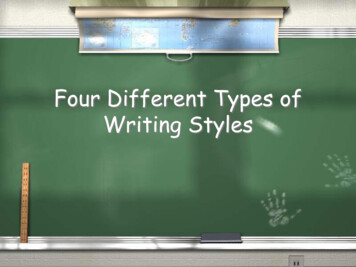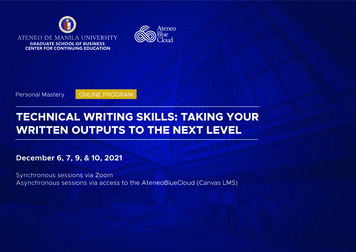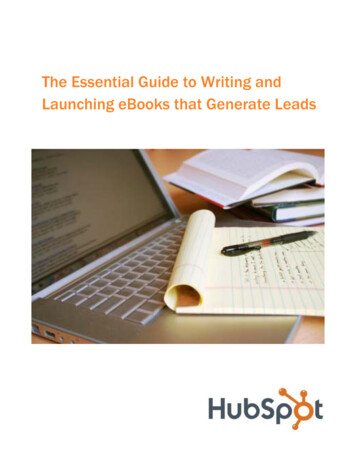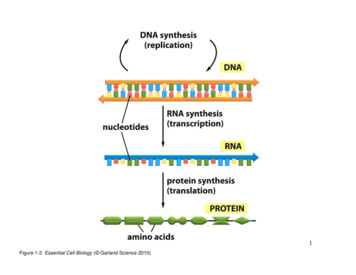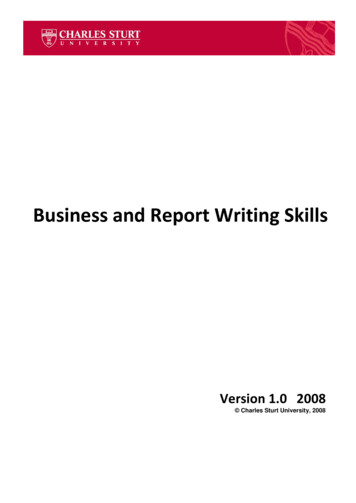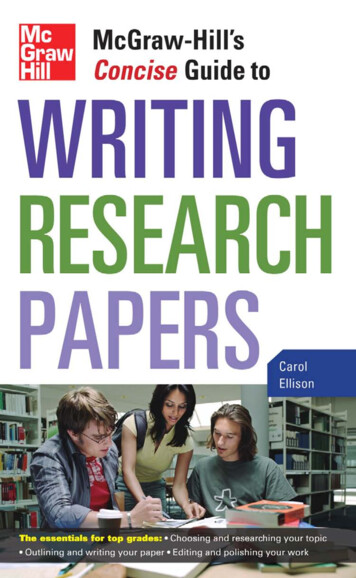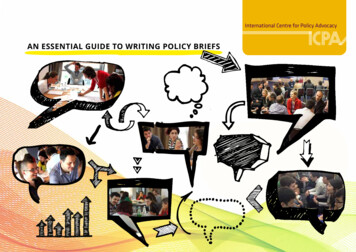
Transcription
An Essential Guide to Writing Policy Briefs 1AN ESSENTIAL GUIDE TO WRITING POLICY BRIEFS
2 2017 International Centre for Policy AdvocacyPublished by:International Centre for Policy Advocacy (ICPA) gGmbHGottschedstr. 413357 BerlinGermanyAuthors: Eóin Young & Lisa QuinnEditor: Lisa QuinnDesign: Design HQABOUT ICPAThe International Centre for Policy Advocacy (ICPA) is anindependent, Berlin-based NGO dedicated to bringing morevoices, expertise and evidence into policy decision-making andpromoting an enabling environment where policy decisions aregrounded in the public interest.www.icpolicyadvocacy.orgTwitter: @ICPAdvocacyTel: 493021958979Email: publications@icpolicyadvocacy.org
An Essential Guide to Writing Policy Briefs 3This guide is dedicated to the memory of ICPA’s trainingassociate and renowned Liberian civil society activist,G. Jasper Cummeh, III (1970-2014).ACKNOWLEDGEMENTSThis guide is a culmination of more than a decade providingtraining and mentoring support and discussing policy briefswith hundreds of researchers, advocates and partners. Thisguide was truly made in dialogue with these many individualsand organisations, and ICPA is very grateful for their input andsupport. Particular thanks to Ana Stevanovic, co-ordinatorof ICPA’s Policy Bridging Initiative for her excellent researchsupport and our training associate, Bego Begu for thoughtfulfeedback on a draft of the guide. Thanks also to those who tookthe time to respond to our survey and share their experiencewriting and using policy briefs. The authors really appreciatethe fresh and professional design of this guide by OonaghYoung of Design HQ. Finally, we would like to acknowledgethe support of the team from Regional Research PromotionProgramme of the Western Balkans (RRPP), Nicolas Hayoz,Jasmina Opardija, Magda Solska, Arbesa Shehu and Ann Killerwithout whose support the production of this guide would nothave been possible. We hope this guide proves to be a worthycontribution to the legacy of RRPP.
4
An Essential Guide to Writing Policy Briefs 5CONTENTS1.1.11.21.31.4INTRODUCTIONWho is this essential guide for?What is covered?What is not covered?How was the guide developed?778882.2.12.22.3THE POLICY BRIEF AS AN ADVOCACY COMMUNICATION TOOLEffective advocacy as dialogueThe target audience and realistic aim for a policy briefPractical use of briefs in an advocacy effort9910103.3.13.23.3.OVERVIEW OF THE POLICY BRIEFPurpose and focus of the briefThe policy brief as one type of policy paperAn emerging new hybrid policy paper?111112134.4.14.2THE STRUCTURAL ELEMENTS OF THE POLICY BRIEFOverview of the structural elements and the policy logicThe structural elements in detail1414155.5.15.25.3THE BRANDING AND LOOK OF POLICY BRIEFSBranding your policy briefBuilding a template for your briefsPresentation and layout for the skim reader171717186.SEVEN KEY LESSONS FOR POLICY BRIEF WRITERS197.WRITING CHECKLIST TO PLAN YOUR BRIEF218.TWO SAMPLE POLICY BRIEFS22
6
An Essential Guide to Writing Policy Briefs 71. INTRODUCTION1.1 Who is this essential guide for?In this essential guide, we detail a key communication tool used toadvocate for research or expert-based analysis: the policy brief. It hasbeen widely reported as one of the most popular tools for think tanksglobally in the last decade1. From the research we conducted to developthis publication, 87% of the 93 global think tanks analysed producedsome form of short, more advocacy oriented policy paper.While many in the policy advice producing community understandablyfocus their efforts on the analytical capacity to be influential, there hasbeen rather less emphasis placed on the need to communicate andadvocate well, even though these elements can be equally (if not more)important in delivering influence. This guide and our other resources seekto redress this balance and support those interested in enhancing thestandard of the communications side of their policy work.This growth in the production and use of policy briefs is recognition thattoo often it is lengthy expert-oriented policy analysis/reports that areproduced and what is missing are shorter, more practical communicationtools that can engage informed, non-specialist audience(s). Recentstudies also attest that access to policy advice in such formats is thedesired starting point for new policy ideas and proposals by civil servants2and briefs are effective in creating “evidence accurate beliefs” amongthose who don’t hold strong opinions on an issue3. Beyond think tanksand researchers, we can also see a broader group of NGO advocates whofeel that the brief and a policy engagement approach are an importantaddition to their existing advocacy toolkit.This essential guide builds on our popular guides on policy paper writing4and the policy advocacy process5, and is an important addition to the setof ICPA resources. The guide pulls together insights from our work overthe past 15 years in building the policy research, writing and advocacycapacity for thousands of researchers and advocates. It was developedas a resource for the “Policy Bridging Initiative”6 in which we supportedresearchers participating on the Regional Research Promotion Programmein the Western Balkans (RRPP)7 from 2014 to 2016.Specifically, the guide is intended for those writing policy briefs (e.g.researchers, advocates, think tankers, civil servants) and those overseeingor commissioning policy brief development (e.g. research directors,managers, donors, civil servants). Beyond guidance for individual briefs,we also hope to contribute to standard setting in research and advocacyproducing institutions. Indeed our original short guide to policy briefwriting8 produced for the International Policy Fellowship of the OpenSociety Institute has been cited widely and used in standard settingprocesses for example, by UNESCO in Paris and Centre for EuropeanPolicy Studies, Brussels9.A key aspect of our work is striving to make core policy knowledgeaccessible to a wide range of policy actors with varying capacity, fromnovice to seasoned advocate. So, you don’t have to have a backgroundin public policy or political science to be able to access and grasp theconcepts and insights in this and our other resources.
81.2 What is covered?1.4 How was the guide developed?Following the approach used in our previous policy writing manual, wecover the following elements: the context of usage of policy briefs; how toput them together; and lessons from practice. Specifically we cover thefollowing:Following a genre analysis method10, we began our analysis of communication tools by reviewing other guidelines11 and literature on policy briefsand we then conducted extensive analysis of real samples of briefs todig deep into the structural and textual patterns that are common to thebrief. In this manner, the advice provided is descriptive of the evolutionof the communication tools, not prescriptions based on our subjectiveopinions. We have brought these insights to our training and mentoringover the past 15 years and sharpened these insights and our analysis indialogue with our team and the researchers and advocates we’ve workedwith. These insights from practice are the backbone of the guide. The policy brief as a advocacy communication tool The purpose and focus of the policy brief The brief as one type of policy paper The structural elements of the brief The branding and look of the brief Key lessons for policy brief writers A writing checklist to plan your brief Two full sample policy briefs1.3 What is not covered?The scope of a short, essential guide has limitations in comparison to ourother manuals. What is not included is a more in-depth analysis of thetextual features of each structural element and the use of parts of samplepapers to illustrate the elements.To bring our insights even more up to date and test some of our ownassumptions about the development and usage of policy briefs, we alsoconducted research on the positions and importance of the policy brief forthink tanks today. We looked wide and deep in this research by conducting an online analysis of policy briefs on think tank websites and also surveying think tankers for deeper insights. Specifically, we did the following: Wider insights – Taking the think tanks listed for each of the 10 globalregions of the 2015 ‘Go to Think Tanks’12 list, we identified the first fivefrom the top of each regional list that produced short, advocacy-oriented policy papers (or briefs). In this analysis, we looked at the namethey used for the brief, how they described the function and audiencefor their briefs, and the length and look of their briefs. We soughtmostly to test our assumptions about briefs at the global level in this(admittedly) thin first level of analysis. Deeper insights – We surveyed 80 think tankers mostly from East &Central Europe on the importance, usage and process of developmentof policy briefs in their organisations. We used an online questionnaireand got a 25% response rate. Obviously, this analysis may have someregional bias, but we were focusing on the networks where we haveworked in an effort to get a reasonable response rate.
An Essential Guide to Writing Policy Briefs 92. The Policy Brief as anAdvocacy Communication ToolThis opening section defines the context in which policy briefs areused. This frames an understanding of the role of the policy brief as acommunication tool in a research-based advocacy process. Specifically,we cover the following: Effective advocacy as dialogue The target audience and realistic aim for a policy brief Practical use of briefs in an advocacy effort2.1 Effective advocacy as dialogueEffective policy advocacy is a process of engaging in dialoguetowards ownership and influence.Based on extensive experience and elaborated in-depth in our advocacymanual13, effective policy advocacy can be simply understood as aprocess of engaging in dialogue towards ownership and influence. Themistake that many researchers make is to see the process as a oneway transfer of expertise from the academic/expert sphere to the policysphere. In contrast, an effective approach to advocacy is decidedly twoway, and which we defined in our manual as follows:In practical terms, this often means designing and putting together a setof activities and communication tools for various target audiences (as inTable 1 below) and hopefully allowing them to understand your ideas, beconvinced by them, and ultimately make them their own and then act onthese ideas.AudiencesExpertsInformedThe Publicnon-specialistsAdvocacy tool 1Policy StudyPolicy BriefPress ReleaseAdvocacy tool 2MeetingsMeetingsLobbying AssociationsAdvocacy tool 3 ConferenceConferencePress Conference&Social MediaTable 1 – The policy brief in an example advocacy planIf you wish to dig deeper into this policy advocacy planning process,we suggest you use our Advocacy Planning Framework (See Figure 1below for a flavour) to come up with a plan that works for your towards afeasible policy change objective.Figure 1 – The Advocacy Planning FrameworkDetailed mapping and planning processWAY INTO THEPROCESS“Policy advocacy is the process of negotiating and mediating adialogue through which influential networks, opinion leaders, and,ultimately, decision makers take ownership of your ideas, evidence,and proposals, and subsequently act upon them”. (Making ResearchEvidence Matter, p.2614)THEMESSENGERMESSAGE ANDACTIVITIESCore strategic focus for your campaignCurrent obstaclesfor change The leverage youcan bring and use Feasible advocacyobjective
102.2 The target audience and realistic aimfor a policy briefThe main audience for the policy brief is informed,non-specialists.The policy brief is a policy document produced to support an advocacycampaign with the intention to engage and persuade informed, nonspecialist audiences. These are people who work regularly on theissue addressed in a brief, but will mostly not conduct policy researchthemselves or read expert texts. Examples of this target audience aredecision makers, politicians, NGO advocates, and journalists. Of course,you can meet decision makers and others listed who are experts, butmore often, this is the circle of people who depend on getting expert inputfrom others. And maybe most significantly, they are often the key decisionmakers and opinion leaders.As Table 1 above illustrates, the policy brief is normally used as onetool in a broader advocacy campaign. Being such a short paper, it isnot normally enough on its own to convince an audience to act on theproposals put forward; rather the more realistic aim is for audiences tobecome interested and want to find out more about the analysis. To usea fishing analogy, we are trying to hook them in and pique their interest.After reading your brief, you are really hoping that they call you to arrangea meeting, invite you to present more on your ideas, or even ask theirown experts to investigate further (e.g. in a government department).The policy brief aims to hook audiences in, getting theminterested in your analysis and proposals.2.3Practical use of briefs in an advocacy effortIn terms of the inclusion of the policy brief in advocacy efforts, there are anumber of ways it can be used. The most common ways this tool is usedare: Posted online on the campaign or organisational website as a PDF; Sent as a PDF to a partner/stakeholder email list; Some even still post in paper format to a partner/stakeholdermailing list; Used as a supporting document for meetings/lobbying,presentations and press conferences; Shared on social media feeds of all kinds.In more recent times of social media developments, elements includedin the brief, e.g. visuals, key messages and striking facts, are also usedin social media posts and in social media tools, such as infographics. Ofcourse, this is not always a one-way street and these elements can evenoriginate from plans for social media engagement and then feed back intothe brief.Be realistic about what a policy brief can achieve: it’s importantbut not sufficient in convincing your target audience.
An Essential Guide to Writing Policy Briefs 113. Overview of the Policy BriefThis chapter outlines key insights needed tounderstand the policy brief as a communicationtool, and covers the following: Purpose and focus of the policy brief The policy brief as one type of policy paperWe close with a section on an interesting findingfrom our research on an emerging new hybridpolicy paper.ENGAGING – as an advocacy tool trying toengage your target audience, it is best toforeground the unexpected or striking facts/insights that were found in the research oranalysis, e.g. a trend or story that challengesa commonly held point of view on the issue.Leading with something surprising or challengingcan create the cognitive dissonance15 neededfor these audiences to really want furtherclarification, and thereby serve your purpose.SUCCINCT – Audiences for policy briefs do notusually have the time or inclination to read anin-depth 20-page (or more!) argument on apolicy problem. Therefore, it is common thatpolicy briefs do not exceed six to eight pages,but are more commonly no more than fourpages. By succinct, we also mean in expressionor put more simply, the reader expects shortsentences with an easy clarity and flow.Keep it short and easy to readLead with striking facts3.1 Purpose and focus ofthe briefWith the understanding from the last sectionthat the brief is one advocacy tool which ispart of a broader plan to influence change, thewriter/advocate’s purpose in producing a policybrief is:To engage and convince your informed,non-specialist target audiences that yourpolicy proposals are realistic, credible andrelevant for the debate and decision on thetarget issue.In constructing a policy brief that can effectivelyserve this intended purpose, it is common for abrief to be:POLICY RELEVANT & FOCUSED – All aspects ofthe policy brief need to framed in the discussionthat the target audience is currently having onthe issue and the questions they are asking, i.e.be policy relevant. This is often challenging whenyou come from discussing the issue only in aresearch or expert circle.Link to the audience discussionPROFESSIONAL, NOT ACADEMIC – Theaudience for the policy brief is not normallyinvested in the research/analysis proceduresconducted to produce the evidence (beyondbeing assured they are reliable), but are veryinterested to know the writer’s new insights onthe problem and potential solutions based onthe new evidence presented.Focus on the practicalLIMITED – To provide a targeted argumentwithin four pages, the focus of the brief needsto be limited to particular aspects of the broaderproblem considered. This focus is normallychosen based on what you think would beimportant or striking for the intended audience.In only presenting the tip of the iceberg, manyresearchers worry about this reduction incomplexity of the argument, but remember thebrief is only intended to open the argument, notcomplete it.Don’t try to include the whole analysisUNDERSTANDABLE – This not only refers tousing clear and simple language (i.e. not thejargon or concepts of an academic discipline)but also to providing a well-explained andargument that is easy to follow and really targetsyour broad, but knowledgeable audience.Simple explanation instead of jargon
123.2 The policy brief as one type of policy paperACCESSIBLE – The writer of the policy brief should facilitate ease of useof the whole document and allow multiple points of entry to the mainmessage for the skim reader. Therefore, such features as layout, subtitles,visuals/tables/graphs and ways to highlight the key messages are all veryimportant. In fact, a small accessibility test for the brief is to see if themain message is clear without reading any of the main text!Make the message stand outBRANDED & PROMOTIONAL – Organisations that produce briefs usemany promotional or marketing features, e.g. professional layout, use ofcolour, logos, photographs, slogans, illustrative quotes. The idea is notonly to enhance the access or professional look, but also to brand them,i.e. all briefs from the organisation will look the same. This is important asyou are trying to build recognition, track record and the reputation of yourproducts and advice.Make it your ownPRACTICAL & FEASIBLE – the policy brief is an action-orientedtool targeting policy practitioners. As such, the brief must providearguments based on what is actually happening in practice and proposerecommendations that seem realistic to the target audience.Tackle the real issuesIn our guidebook on policy paper writing16, we focused more or lessexclusively on the longer, research-driven policy papers that target expertaudiences, i.e. what we call the policy study. So, to go further with thisoverview of the policy brief, it is important to explain and clarify thesimilarities and differences between these two important types of policypapers.First up is a clarification of the names we have chosen in identifying thesetypes of papers. What is really confusing in looking at policy papers indifferent institutions is how many different names are used for differenttypes of papers! However, looking at the stated purpose and audience forpapers, what is common is that most have a more expert-oriented longpaper and also have some version of a short, more advocacy-orientedpaper. And this finding that led us to focus on these 2 types. The reasonwe chose to focus on the names ‘study’ and ‘brief’ are: they are commonly used;they nicely illustrate what each paper contains;they contrast nicely.POLICY STUDYPOLICY BRIEFPolicy reportBriefingPolicy research paperPolicy analysisResearch paperPolicy briefingPolicy paperPolicy memoPosition briefPosition briefingPosition paperFact sheetTable 2: Commonnames for study andbriefThis table shows anon-exhaustivelist of some of thecommon names foreach type.So, we have brokendown the core qualitiesof each paper in thefollowing table:
An Essential Guide to Writing Policy Briefs 13Type of Policy Papers:Areas of DifferencePOLICY STUDYPOLICY BRIEFAudienceTargets other policy specialists or expertsTargets an informed, non-specialist audience (e.g. decisionmakers, NGO advocates, journalistsFocusIssue-driven: In-depth analysis of policy issues and optionsavailable based on researchAudience-driven: Specific policy message designed toengage and convince key stakeholdersContext of UseFocused on influencing current expert thinking on the policychallenge (and informs the brief)Used as a tool to support advocacy activities in order starta conversation/get the interest of non-specialist audiences(links to the study)MethodologyUsually includes a lot of evidence based on primary researchOnly includes the key findings from the primary research(‘tip of the iceberg’)Ideas/Language usedCan be quite discipline specific/technicalMust be very clear and simpleLength35 to 60 pages4 to 8 pagesTable 3: Differences between policy study and briefFrom our analysis, the key point of contrast between the study and briefis the target audience. While both are advocacy tools, what it takes toengage, interest or convince these different target audiences is indeedvery different. For an expert audience to be convinced of a new policyidea, they need to see a policy study which outlines the whole in-depthpicture of the argument and proposals supported by credible researchevidence and informed analysis. For a non-specialist, but informedaudience, the most important or relevant findings from the researchwill usually be enough to make them want to engage with your ideas.But for clarification or confirmation on the strength and validity of newideas, such non-expert audiences often turn to expert advisors. As policydiscussions or advocacy activities continue, these audiences often cometogether in the discussion and decision-making, and hence, both needto be convinced.A study targets the expert discussion and a briefthe professional/practitioner one.3.3An emerging new hybrid policy paper?An interesting finding from our research with think tankers in EasternEurope and analysis over recent years is the emergence of a type ofhybrid paper between study and brief which is about 20 pages long andoften looks more promotional and polished, i.e. like a brief. According tothose surveyed and conversations with researchers, their clients/partnersoften ask for an analysis of an ongoing issue in a short turn-around timeand with a relatively small budget. In these circumstances, there is notthe time nor resources to conduct large-scale research, but evidence isstill required. So, it looks like this hybrid is a shorter study that is alsosupposed to be quite accessible to broader audiences. From a communications perspective, this is a difficult space to inhabit – being allthings to all audiences. We will further follow the evolution of this hybridto see if it becomes more widely adopted. Nevertheless, the shorterbrief remains a key tool and challenge for many and hence, the guide isfocused on this.
144. The Structural Elements of the Policy BriefHaving provided a background to the focus, purpose and role of the briefin the advocacy process, we next move onto how it is commonly structured. This section first provides an overview of the structural elementsof the brief, and covers the key steps in any policy argument: the policylogic. Next we break down each of the elements and talk about its role inthe brief and how it’s constructed.4.1 Overview of the structural elements and thepolicy logicThe three elements highlighted at the core of the policy brief are theelements that are central to any policy argument, which we call ‘thepolicy logic’. This logic represents a movement in the argument asrepresented in Figure 2.A clarification before fleshing out the structural elements in detail: thesesuggested elements are not a set of handcuffs or a blueprint that youmust follow! They outline a set of common reader expectations, butthere is still space for you to be creative in how you use them to suit yourpurpose. In fact, writers frequently experiment with writing approaches(but in a strategic way!).The key structural elements commonly found in the policy brief are:THE POLICY BRIEF1. TitleFOCUSKEY QUESTIONS ANSWERED3. Rationale for action on the problemProblemWhy do something different?4. Proposed Policy Option(s)SolutionWhat to do? (And what not?)5. Policy RecommendationsApplication How to implement?2. Executive Summary6. Sources consulted or recommended7. Link to original research/analysis8. Contact detailsFigure 2 – Common structural elements ofthe policy brief and the policy logic
An Essential Guide to Writing Policy Briefs 154.2The structural elements in detail1. TITLEMake it ‘sticky’!As an advocacy tool, the title of the brief isan important opening element in grabbing theattention of the reader and may also be used tostart communicating the essence of your message. Beware of just cutting and pasting moreacademic titles; instead try to make your title‘sticky’, for example, “An equal chance for localself government” rather than “An analysis of theeffects of fiscal equalisation formula on publicservice delivery at municipal level in BiH”. Whilethis second title may be suitable for a policystudy, it focuses on reporting the research, notcommunicating your message.2. EXECUTIVE SUMMARYGrab the readers attention!Even though the brief is short, most include aone or maximum two-paragraph summary, withthe aim to clearly state the core findings andrecommendations in the paper and further grabthe reader’s attention. It normally includes clearstatements on the following issues: The specific issue or problem addressed inthe brief; The most striking policy failures or insightsidentified; The shape or main focus of yourrecommendations.Remember this may be the only thing somereaders read, so make it ‘punchy’ and memorable. If effective, it will hopefully entice readers toread on.3. RATIONALE FOR ACTION ON THEPROBLEMKey question: why do something different?This part of the policy brief is focused on theproblem. The aim in this section is to presentthe most striking facts or elements of youranalysis in order to convince your audiencesthat they may need to rethink the issue andultimately, may need to change the currentpolicy approach, i.e. you provide a reason to actdifferently. This element of the brief normallyincludes sections which: Frame the paper, by detailing the policyproblem in the local context; Develop the core issues or striking facts thathave lead to current policy failures; End with what the impact of these policyfailures are having.In our research, we have found that most writersinclude no more than 4 or 5 most striking pointsof policy failure or interest in this section anddevelop on those, rather than trying to summarise the whole research project they havedone.4. PROPOSED POLICY OPTIONSKey questions - What to do? And what notIn this element, you are getting to the choice ofstrategic policy alternatives you have identifiedto fix the identified failure. Depending on thefocus of your brief, this element can be quitedeveloped or shorter: those wanting to discussoptions will make this a main element of thepaper, whereas someone wanting to focus onsuggesting a new solution may only mention thestrategic options and then develop the recommendations section more (see ‘dealing withspace’ question below). For those interested indeveloping the section, your aim is to presenta convincing argument for the option you havechosen. The element normally includes sectionson the following: The options or alternatives considered; The principles and evaluation criteria youhave used to weigh up the options; An argument on why you have chosen oneoption over the others available.It is important to remember that the level of discussion in this element is at the strategic level,e.g. papers focused on regulatory change oftenweigh options where the government is playingthe lead role or the market does the job. Thespecifics of how you propose to implement thisapproach will follow in the next element.
165. POLICY RECOMMENDATIONSKey question – How to implement?Next comes the specifics of how to implementthe option you have chosen. The aim here isto put forward a feasible and practical set ofrecommendations that could deliver the chosenoption and convince the reader you understandhow policy systems and government programmes work. This element normally includessections on the following: The specific sets of actions that variousactors should take to deliver your chosenoption; Sometimes also includes a closingparagraph re-emphasising the importance ofaction.The issue of space in the brief is often a challenge in this section, i.e. how much detail toinclude? The balancing act lies in demonstrating the feasibility and fit of the option, but notpresenting a full action plan. This section oftenfeatures recommendations divided by actor (e.g.what local governments should do) and a synopsis of the series of actions presented usingbullet points or numbers.6. SOURCES CONSULTED OR RECOMMENEDEstablish your credibility!This element can be one of two things:Sources consulted –It can simply be a list of the sources referencedin the paper. As in an academic paper, you aretrying to support the key points of the argumentwith strong sources. It is worth noting that policybriefs normally do not include an extensive listof sources – just the key ones.Sources recommended Alternatively, this section may list other readings that you or your organisations have produced that can further inform the discussionin the brief. The intention is to show you havea reputation and a track record of commentary and analysis in this area. This approach isnormally taken by more established think tanksor commentators and also means that you feelthat you have the reputati
An Essential Guide to Writing Policy Briefs 3 This guide is dedicated to the memory of ICPA’s training associate and renowned Liberian civil society activist, G. Jasper Cummeh, III (1970-2014). ACKNOWLEDGEMENTS This guide is a culmination of more than a decade providing tr





